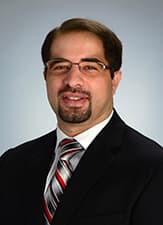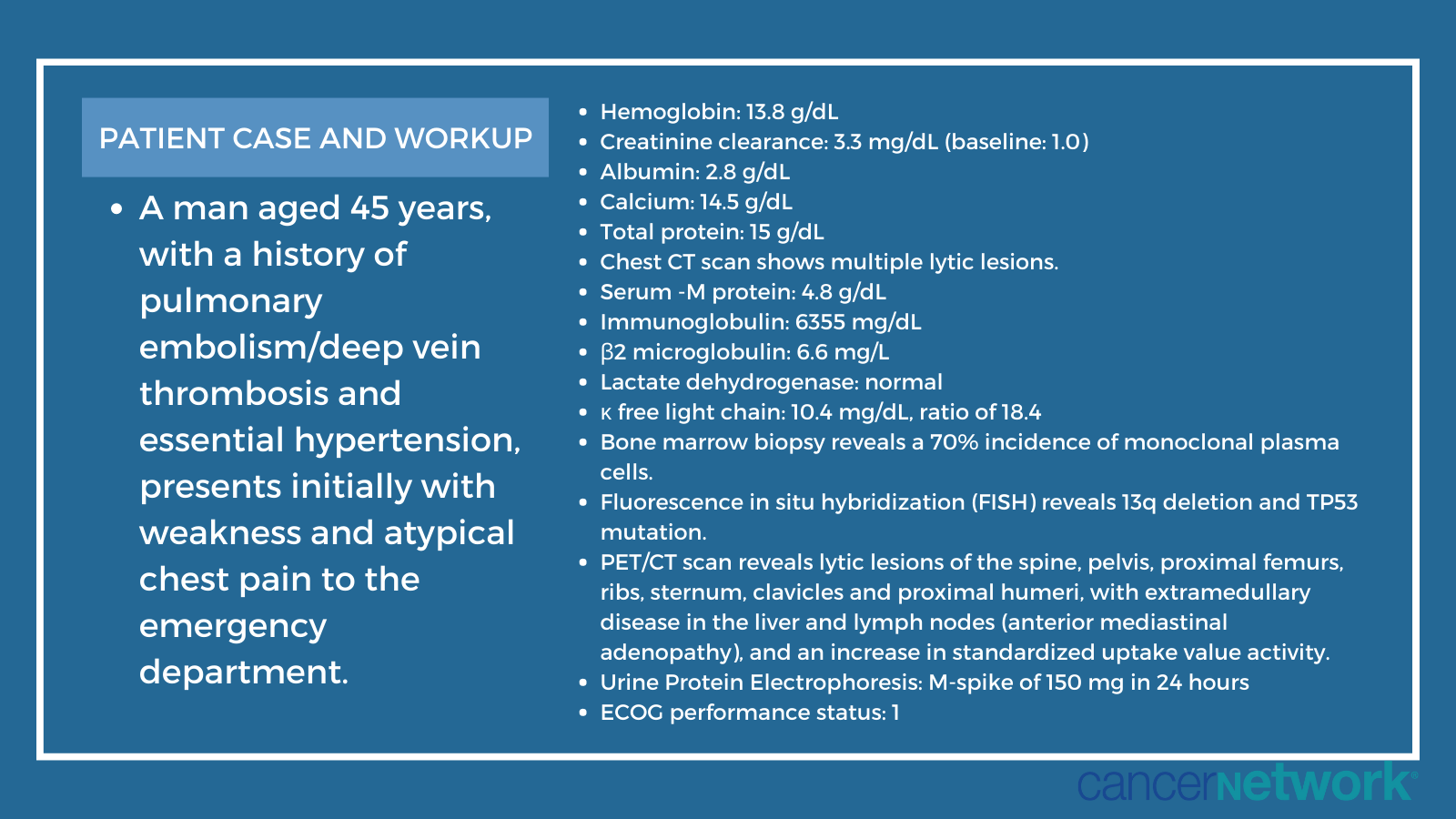Experts Spotlight Some of The ‘Biggest Concerns’ In Multiple Myeloma
The standard of care for high-risk multiple myeloma remains unsettled, according to an expert panel from Kansas City.
Al-Ola A. Abdallah, MD
Assistant Professor

Nausheen Ahmed, MD
Assistant Professor

Leyla O. Shune, MD
Associate Professor

Jordan Snyder, PharmD
PGY-2 Oncology Pharmacy Resident

A panel of experts tackled a complex patient case at a recent Around the Practice® program hosted by CancerNetwork®. During the discussion, panelists also touched on various recent trials in this space and discussed current practices in the care of this disease. The panel was led by Al-Ola A. Abdallah, MD, an assistant professor of hematologic malignancies and cellular therapeutics from Kansas City, KA.
The panelists were also from Kansas City and included Nausheen Ahmed, MD, an assistant professor of hematologic malignancies and cellular therapeutics; Leyla O. Shune, MD, an associate professor of hematologic malignancies and cellular therapeutics; and Jordan Snyder, PharmD, a PGY-2 oncology pharmacy resident.
Some of the topics covered during the panel include the role of transplantation, the most important unmet needs in the multiple myeloma space, and the ambiguous, unsettled standard of care for patients with high-risk disease. The panel also discussed the challenges of educating community providers and working to expand these optimal therapies to those practices.
Patient Case

The GRIFFIN Trial
Abdallah: Can you update us on the efficacy of the adding daratumumab [Darzalex] to triplet therapy?
Shune: The phase 2 GRIFFIN trial [NCT02874742] tested the addition of daratumumab to our standard of care: lenalidomide [Revlimid], bortezomib [Velcade], and dexamethasone [RVd].1 The trial presented updates at 64th American Society of Hematology [ASH] Annual Meeting and Exposition in 2022, which is the 4-year follow-up. It showed that patients diagnosed with multiple myeloma were randomly assigned to receive daratumumab plus RVd [DRVd] or RVd induction therapy, followed by autologous transplant, followed by consolidation, and then onward to daratumumab plus lenalidomide vs standard-of-care lenalidomide maintenance. In that update, at 4 years, the DRVd arm showed improved progression-free survival [PFS], almost double what the standard of care RVd arm experienced. When they looked at the subgroup analysis, DRVd showed superior stringent complete response [CR] rates and minimal residual disease [MRD] negativity across the board. This was among patients older than 65 [years old] who are African American with high-risk multiple myeloma. These patients have 1 cytogenetic risk factor and have extramedullary disease.
DRVd has [produced] significant improvement in PFS among patients with newly diagnosed transplant-eligible multiple myeloma across risk categories. However, this is a phase 2 trial, and we don’t have overall survival [OS] data to support this yet. There are studies similar to GRIFFIN being conducted in a phase 3 setting, and we’re looking forward to hearing the results from these studies. In the interim, we and our community doctors have started adopting DRVd as induction therapy for patients who have newly diagnosed, transplant-eligible multiple myeloma.
Abdallah: Since [GRIFFIN], we’ve been doing more induction therapy with 4 drugs. One thing I notice in the real-world is that, post-transplant, we’re [often] not following the GRIFFIN trial [guidelines]. In standard-risk disease, a lot of community doctors tell me they’re following guidelines from other institutions. They switch to maintenance therapy lenalidomide as the backbone for standard-risk [disease]. If [patients have] high-risk [disease], they switch to bortezomib and lenalidomide.
I’m a little surprised by that. If we believe daratumumab is that effective, we have to give it a chance in maintenance therapy. Are we going to lose the PFS and maybe OS benefit if we drop the daratumumab upfront? It’s too early to make any modification without strong evidence. One of my biggest concerns is seeing 4 cycles of daratumumab alone, and then dropping it. I’m not seeing a lot of physicians following the GRIFFIN trial, especially in high-risk disease.
Autologous Stem Cell Transplantation
Abdallah: What is the present role of autologous stem cell transplantation [ASCT] in this disease space?
Ahmed: We do transplants at many institutions. Nationally, we still have an upfront transplant as a standard of care, and it’s based on the phase 3 IFM 2009 trial [NCT03679351], which randomized patients to get RVd followed by maintenance or RVd with transplant and then maintenance.2 There was a PFS advantage among those who got a transplant. It was a 1- to 2-year difference, which is significant in the long run for patients with multiple myeloma.
More recently, the results of the phase 3 DETERMINATION trial [NCT01208662] were published in the New England Journal of Medicine, which had 2 arms: RVd induction followed by transplant and then maintenance vs induction followed by maintenance, which would continue to progression.3 There was a good number of patients, more than 300 in each arm. In that study, the patients who didn’t get the transplant had a PFS of around 3 years. In the other arm, in the ones who had a transplant, it was 5 to 6 years. You’re seeing a 2-year difference in PFS.
We haven’t seen an OS difference, but that’s because patients in both groups do well for a long time. We haven’t had the chance to capture that difference. We’ll see how things roll out, but given the data we have, this is still standard of care.
Abdallah: I agree. We also have to agree that a high-risk multiple myeloma transplant is where we need to push for [this patient case]. This is a fit patient in his 40s. I prefer to get longer PFS for this patient.
Patient Case (continued)

[Regarding DRVd], there was always a concern that adding a fourth drug like daratumumab might impact stem cell collection. Has this concern been borne out?
Snyder: Yes, absolutely. The addition of daratumumab to RVd in the GRIFFIN trial resulted in numerically fewer stem cells collected, but it didn’t seem to affect the ability to cryopreserve for additional transplants should a patient need it. It’s important to note that [patients who received daratumumab] did require more plerixafor [Mozobil] upfront vs patients who received only RVd, which can increase costs and adverse effects [AEs] for these patients. As far as AEs go, adding daratumumab to RVd resulted in higher rates of cytopenias, particularly neutropenia, and thrombocytopenia. [There were] higher rates of infection, but when we look at [rates of] grade 3/4 infections between the treatment arms, they were similar. For patients who received daratumumab, the majority of infections were mild and could be managed easily.
Abdallah: It’s important to look at the benefit of adding a drug, and whether the benefit [outweighs] any [added] AEs.
High-Risk Disease
Patient Case (continued)

Shune: [When looking at the patient case], this patient has extramedullary disease. Even though it’s not regarded as one of the high-risk features, it’s clearly a high-risk feature of multiple myeloma. People who have circulating plasma cells are considered [to have] high risk [disease]. In this case, his cytogenetic risk factor is that he has a TP53 mutation or 17p deletion, which is a high-risk feature. Other high-risk features include t(4;14), t(14;16), t(14;20), and amplification of 1q. It could be 3 or more [features]. Chromosome 1q amplification is also considered to be a high-risk feature. There are other features of high-risk disease [examined] at different centers, but for the general public, from the International Myeloma Working Group [IMWG] criteria, we use the high-risk cytogenetics, extramedullary disease, and circulating plasma cells. These are the features of high-risk disease.
Abdallah: That prompts a lot of questions. We’re talking about [these patients] as a subgroup, and we’re going through the same mistake because we’re enrolling [them] in the same treatments. In the GRIFFIN trial, we’re talking about DRVd. We need to focus on separating out [the high-risk] group and trying to find a standard of care. If you look at a lot of algorithms, they always use a different category for these patients, and at different lines of therapies. That’s my biggest concern. Is the GRIFFIN trial going to be the standard of care for high-risk disease? When I look at many algorithms, they’re not following any clinical trials; they have a different approach for these patients. That’s one of the biggest concerns in high-risk multiple myeloma.
Shune: High-risk disease affects about 20% of all patients with multiple myeloma, and they need to be studied intensely and to improve their outcomes, which are still lacking.
Abdallah: [The lack of trials in high-risk multiple myeloma] causes frustration. One of the [few] trials is the phase 2 SWOG-1211 trial [NCT01668719].4 They took patients with high-risk disease and enrolled them to get RVd with or without elotuzumab [Empliciti]. That’s a good study because it was in high-risk disease. [However], they opted not to give them transplants. The results were disappointing. The PFS and OS were similar. [However], it opened our minds that this could be a standard of care that we start with. When I look at that study, maybe that’s why we still call bortezomib a proteasome inhibitor and lenalidomide an immunomodulatory [IMiD] drug, because they’re the backbone for treating high-risk multiple myeloma. We can’t omit transplantation in these cases.
The phase 2 MASTER study [NCT03224507] was [also good] because 60% of the [included] patients had high-risk multiple myeloma.5 The design of the MASTER trial was significant. The 1 negative thing is that it was only a single arm, so we don’t know the standard of care. It [examined] DRVd and transplant, and then consolidation therapy with 4 drugs for about 8 cycles, and then maintenance lenalidomide. They used MRD testing in each session to identify if they could stop treatment. I like that because it decreases toxicity, but it doesn’t answer a lot of questions about the rule for continuing treatment or switching to a different maintenance therapy.
MASTER is a good start, but it didn’t give us the real standard of care for high-risk multiple myeloma. It’s a good start to see how we can utilize MRD testing. The reason I don’t do MRD testing in the real world is that I don’t know what to do if you tell me the test is negative. In a patient with high-risk multiple myeloma, would I stop the treatment? No, I’m not going to stop the treatment. I want to keep him alive. If the patient is positive, what am I going to do? If there are multiple myeloma markers and no extramedullary disease or anything like that, then I’m not going to change the treatment. We need more trials to tell us how to use MRD testing.
What definition of an adequate response can we use to inform local oncologists?
Ahmed: The question is: how deep do we want a response to be before we go into a transplant? What’s the significance of achieving a CR before vs after a transplant? The studies are all over the place, so there’s no great data to support [a need for] a CR before transplant.
However, generally, a CR either before or soon after the transplant would translate into a better PFS and better outcomes. I like to see some response. It doesn’t have to be a CR; it could be a partial response [PR] or a very good PR. I [just] want some response. If I see that a patient is resistant to therapy—if they’ve hardly had any response—then we sometimes have to switch gears and try another induction before we get to transplant. Generally, as soon as we see any kind of response, we try to take them for transplant. We also assess [the] bone marrow biopsy and the percentage of plasma cells when considering if a patient is ready for transplant.
Perspectives on the Future
Abdallah: What are some unmet needs and prospects for the future in the treatment of newly diagnosed and relapsed multiple myeloma?
Shune: An area of need is among patients with high-risk multiple myeloma; they should be [selected] out and treated with the most unique [drug] combinations. Another area of need that concerns me is plasma cell leukemia. The management of these patients is excluded from most clinical trials. How do we define plasma cell leukemia? How do we treat it? How do we improve on treatment?
Ahmed: We still have a lot of work to do to get [practices and treatments] out into the community. Patients who are eligible for CAR T-cell therapy, for example, are still not reaching the centers that provide that service. I would like to see care delivery become easier and closer to home, whether it’s CAR T [or] bispecific antibodies. There’s a lot of movement in that direction, but we still have a long way to go.
Snyder: It’s an exciting time right now in the multiple myeloma space. [For the future], I’d like to see more information on sequencing. We have multiple B-cell maturation antigens [BCMA] targeting agents. Where should they fall in [a sequence of treatments]? Can we move some of them earlier to improve PFS and OS? That’s what I would like to see in the future.
References
- Chari A, Kaufman JL, Laubach JP, et al. Daratumumab plus lenalidomide, bortezomib, and dexamethasone (D-RVd) in transplant-eligible newly diagnosed multiple myeloma (NDMM) patients (Pts): final analysis of Griffin among clinically relevant subgroups. Blood. 2022;140(suppl_ 1):7278-7281. doi:10.1182/blood-2022-162339
- Perrot A, Lauwers-Cances V, Cazaubiel T, et al. Early versus late autologous stem cell transplant in newly diagnosed multiple myeloma: long-term follow-up analysis of the IFM 2009 trial. Blood. 2020;136(suppl_ 1):39. doi:10.1182/blood-2020-134538
- Richardson PG, Jacobus SJ, Weller EA, et al. Triplet therapy, transplantation, and maintenance until progression in myeloma. N Engl J Med. 2022;387(2):132-147. doi:10.1056/NEJMoa2204925
- Usmani SZ, Hoering A, Ailawadhi S, et al. Bortezomib, lenalidomide, and dexamethasone with or without elotuzumab in patients with untreated, high-risk multiple myeloma (SWOG-1211): primary analysis of a randomised, phase 2 trial. Lancet Haematol. 2021;8(1):e45-e54. doi:10.1016/S2352-3026(20)30354-9
- Costa LJ, Chhabra S, Medvedova E, et al. Early versus late autologous stem cell transplant in newly diagnosed multiple myeloma: long-term follow-up analysis of the IFM 2009 trial. Blood. 2022;140(suppl_1):7275-7277. doi:10.1182/blood-2022-156730
EP: 1.Patient Profile 1: A 45-Year-Old with Transplant-Eligible Multiple Myeloma
EP: 2.Key Updates from the GRIFFIN Trial in Multiple Myeloma
EP: 3.Role of Transplant in Multiple Myeloma
EP: 4.Features of High-Risk Multiple Myeloma and Clinical Trial Landscape
EP: 5.Measuring Treatment Response Following Induction Therapy in Patients with MM
EP: 6.Maintenance Therapy Considerations for Standard- and High-Risk MM
EP: 7.Experts Spotlight Some of The ‘Biggest Concerns’ In Multiple Myeloma
EP: 8.Patient Profile 2: A 79-Year-Old with Multiple Myeloma
EP: 9.MAIA Trial: DRd vs Rd in Transplant-Ineligible Patients with MM
EP: 10.Treatment Considerations for Transplant-Ineligible Patients with MM
EP: 11.CAR T-Cell Therapy in Transplant-Ineligible Patients with MM
EP: 12.Patient Profile 3: A 73-Year-Old with MM Treated with CAR T and Teclistamab
EP: 13.CAR T-Cell Therapy in the Treatment of Multiple Myeloma
EP: 14.MM: CAR T-Cell Therapy vs Bispecific T-Cell Engagers
EP: 15.BCMA Bispecific T-Cell Engagers in the Treatment of MM
EP: 16.Treatment Considerations for Bispecific Antibodies and Unmet Needs in MM
Navigating AE Management for Cellular Therapy Across Hematologic Cancers
A panel of clinical pharmacists discussed strategies for mitigating toxicities across different multiple myeloma, lymphoma, and leukemia populations.